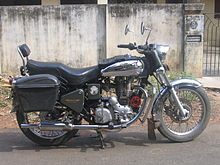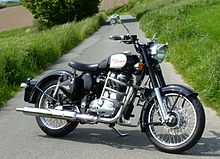Royal Enfield
| Royal Enfield
|
|
|---|---|
| legal form | Corporation |
| founding | 1893 |
| Seat | Chennai , India |
| management | Vinod K. Dasari |
| Branch | mobility |
| Website | www.royalenfield.com |

Royal Enfield is an Indian motorcycle manufacturer and at the same time the oldest still producing motorcycle brand in the world.
The company, which was formed in its current form in 1955, emerged from the British motorcycle manufacturer of the same name , which also produced automobiles and rifles . The company has been a subsidiary of the Indian Eicher Group since 1994 .
Motorcycle production
- 1896 First manufacture of precision parts for bicycles and weapons. The slogan "made like a gun" was based on this time and should stand for quality.
- The first motorcycle was manufactured in 1901.
- 1902 Introduction of a V2 with 300 cm³ and later 350 cm³.
- 1912 Introduction of a 770 cc V-Twin.
- 1914 Introduction of a 225 cc two-stroke engine. After the First World War , only two-stroke engines were produced until 1921, when the 976 cm³ V-Twin replaced them.
- 1924 to 1928 Introduction of the single-cylinder 350 and the head-controlled 500 cm³ single cylinder.
- 1930 Introduction of the 500 cc four-valve engine.
- 1933 First export of the model K with 1140 cm³ abroad.
- 1933 Start of production of the "Bullet" (projectile) with 250 and 350 cm³.
- From 1935 to 1939, a transport tricycle with a payload of 3 cwt (150 kg) was built on the basis of the 225 cm³ motorcycle.
- In 1939 a motorcycle with a 125 cc two-stroke engine appeared . It became known in airborne missions from 1943 during World War II under the name "Flying Flea" . After the war, the two-stroke engine and the two bullet versions continued to be produced.
- 1953 to 1960 various models were marketed as Indian in the USA .
- 1955 Establishment of production for the Bullet in Madras . Parallel twins were also manufactured in England , for example the 500 twin from 1949 to 1963, then the 700 Meteor from 1952 to 1962. The Crusader, built from 1956 to 1966, had a single cylinder engine with 250 cc. The coronation was the Interceptor with 750 cm³, a parallel twin with 52.5 hp (39 kW).
- In 1970 production in England ended with the Interceptor. The Bullet 350 is enjoying increasing popularity in India. The 500 types were exported.
- In 1984 Royal Enfield India took over the rights and names of Zündapp and manufactured the CS-25 / CS-50 mopeds in Madras until the 1990s.
- In 1994, the vehicle manufacturer Eicher Goodearth Ltd. , originally a joint venture between the Indian importer Goodearth and the now extinct German tractor manufacturer Gebr. Eicher , Enfield India and renamed it Royal Enfield Motors Limited.
- In 1999 the naming rights went to "Royal Enfield" in India, so that the motorcycles no longer had to be officially called Enfield India, but could be called "Royal Enfield" again. Around 35,000 of the Bullet were produced annually.
- In 2000 a new factory was opened, the manufacturing quality increased and a new variant of the 350 series was presented in India.
- In 2005, the new left-hand shift Bullet Elektra 500 was introduced in the UK.
- In 2006, the introduction of new emissions regulations ( EURO 3 ) for newly registered motorcycles put the foreseeable end to the history of the Bullet in Europe. There was a grace period for small series both for gasoline engines from India and for most small series conversions to diesel engines. Since fewer than 5,000 units were imported into Europe annually, the Enfield could be registered without problems until December 31, 2007 with the corresponding manufacturer's certificate. A final possibility of approval until December 31, 2008 was made possible by a new and very last exception regulation. The small series manufacturer of diesel motorcycles, the Sommer company, was also still on the market, but was no longer allowed to use the manufacturer name “Royal Enfield” for approval reasons.
- In 2008, the new models with the new engine with intake manifold injection (Electronic Fuel Injection, EFI) also met the requirements of the EURO 3 emissions standard . The engine was initially used in the Royal Enfield Bullet 500 Classic EFI and Royal Enfield Bullet 500 Electra EFI.
- In 2011 the Royal Enfield Bullet 500 Standard EFI comes onto the market. The Bullet 500 Classic EFI was now also available in the Military version.
- In 2012 the "Continental GT" in the style of a 1960s Cafe Racer was presented in Germany at the Intermot trade fair.
- In 2016 the " Himalayan " was presented at EICMA 2016 in Milan for Europe.
- In 2017 a 650 twin-cylinder was announced, which was developed in England.
- In 2018, the Interceptor 650 and Continental GT 650 models came onto the market.
The Bullet 500, a classic long-stroke engine with 22 to 25 hp (16 to 18 kW), which has been produced in India to this day , is now one of the most popular motorcycles in the world.
The company gained further fame by the fact that the Bullet was offered with a diesel engine as one of the few diesel series motorcycles . The separate housings of the engine and gearbox - which were common in motorcycle construction until the 1960s - make the Bullet the ideal basis for these designs, which combined the original gearbox with a subsequently installed diesel engine. For example, there was the Taurus 325 diesel model, which was manufactured by Royal Enfield itself but has long since been discontinued. The later models from Beckedorf, Sommer and Vahrenkamp are regarded as the most technically advanced. So far, the Beckedorf equipped with a Lombardini diesel has been manufactured around 150 times and the Hatz summer diesel and Vahrenkamp diesel around 310 times. Both engines develop approx. 11 HP (8 kW) and give the motorcycles a top speed of 110 km / h.
Current models
All current models are equipped with an air-cooled single-cylinder four-stroke engine.
- Bullet "Classic" 500 (499 cm³)
- Bullet "Classic" 350 (346 cm³, not available in Germany)
- Bullet 500 (499 cm³)
- Bullet 350 (346 cm³, not available in Germany)
- Thunderbird 500 (499 cm³, not available in Germany)
- Thunderbird 350 (346 cm³, not available in Germany)
- Continental GT (535 cm³)
- Himalayan (411 cm³, Enduro, from September 2017)
- Royal Enfield 650 (648 cm³, from 2018 in the Continental GT and Interceptor version)
Automobile production
Between 1901 and 1905 the company also manufactured automobiles. Used came built-in motors of De Dion-Bouton , initially with a cylinder , and later two-cylinder engines . This production was outsourced to the subsidiary Enfield Autocar in 1906 , where from 1907 limited commercial vehicle production was added. The division and its trademark rights were sold to Alldays & Onions in 1912 . In 1919 she merged this with her own automobile and commercial vehicle production and produced as Enfield-Allday in the former Enfield factory in Birmingham-Sparkbrook until 1925. With the acquisition of the trademark rights, Enfield Autocar and Enfield-Allday were also able to use the Royal Enfield slogan "Built Like Use a Gun "(" built like a gun ").
literature
- Dirk W. Köster: Royal Enfield - The legend lives , Monsenstein and Vannerdat , Münster 2009, ISBN 978-3-938568-92-7
- GN Georgano : cars. Encyclopédie complète. 1885 à nos jours. Courtille, 1975 (French)
- GN Georgano (Ed.), G. Marshall Naul: Complete Encyclopedia of Commercial Vehicles. MBI Motor Books International, Osceola WI, 1979; ISBN 0-87341-024-6 .
Web links
- Royal Enfield
- Royal Enfield Germany, Austria & Switzerland
- EifelTec Team GmbH - Royal Enfield importer from 1998 to 2015
- A Cult Motorcycle From India Takes On the World , The New York Times, Jan 3, 2014
- Grace's Guide: Alldays and Onions. (accessed November 23, 2017)
- Grace's Guide: Enfield-Allday. (Accessed November 23, 2017)
- Grace's Guide: Enfield Cycle Co. (accessed November 23, 2017)
- Grace's Guide: Enfield Autocar Co. (accessed November 22, 2017)
Individual evidence
- ↑ Georgano, Naul: Complete Encyclopedia of Commercial Vehicles. 1979, pp. 531-532 (Royal Enfield)
- ↑ Vincent Motorcycles: The Untold Story since 1946
- ↑ Grace's Guide: Enfield Autocar Co.
- ↑ a b Georgano, Naul: Complete Encyclopedia of Commercial Vehicles. 1979, p. 220 (Enfield Autocar; Enfield-Allday)
- ↑ Grace's Guide: Enfield-Allday.








